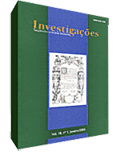A violência simbólica no trovadorismo das cortes medievais ibéricas (séculos XIII e XIV)
Abstract
O objeto deste artigo é discutir a violência simbólica presente nas sociedades medievais ibéricas dos séculos XIII e XIV, examinando a poesia e práticas trovadorescas do período. Dentro do contexto histórico da centralização régia do período medieval, o texto analisa algumas cantigas trovadorescas galego-portuguesas nas quais podem ser vistas as tensões sociais entre trovadores oriundos de diferentes categorias sociais, e também envolvendo trovadores em oposição ao rei.References
CANCIONEIRO DA AJUDA. 1904. Edição Carolina Michaëlis de Vasconcelos. Halle. 2 v.
CANCIONEIRO DA BIBLIOTECA NACIONAL. 1949-1964. Orgs. Elza Paxeco Machado e José Pedro Machado. Lisboa: Ocidente.
CANCIONEIRO PORTUGUEZ DA VATICANA. 1878. Edição de Teófilo Braga. Lisboa.
BARROS, José D’Assunção. 1994. A Arena dos Trovadores — as
representações das tensões sociais no cancioneiro medieval ibérico (séculos XIII-XIV). Niterói: UFF. (dissertação de mestrado).
______. 1999. As três imagens do Rei — o imaginário régio nas narrativas dos livros de linhagens e nas cantigas trovadorescas (Portugal e Castela, séculos XIII e XIV. Niterói: UFF (Tese de doutorado).
DUBY, Georges. 1982. As Três Ordens ou o Imaginário do Feudalismo.
Lisboa: Estampa.
______. 1988. A Europa na Idade Média. São Paulo: Martins Fontes.
ELIAS, Norbert. 1990. O Processo Civilizador. Rio de Janeiro: Jorge
Zahar Editor.
______. 1995. A Sociedade de Corte. São Paulo: Cia. das Letras.
LAPA, Manuel Rodrigues. 1981. Lições de Literatura Portuguesa. Coimbra.
______. LAPA, Manuel Rodrigues. 1975. Cantigas D'escarnho e de mal
dizer. Lisboa: Galáxia.
Downloads
Published
How to Cite
Issue
Section
License
Copyright (c) 2005 José D’Assunção Barros

This work is licensed under a Creative Commons Attribution 4.0 International License.
Authors who publish with Revista Investigações agree to the following terms:
Authors retain copyright and grant the journal right of first publication with the work simultaneously licensed under the Creative Commons Attribution 4.0 International (CC BY 4.0) license that allows others to share the work with an acknowledgement of the work's authorship and initial publication in this journal.
Authors are able to enter into separate, additional contractual arrangements for the non-exclusive distribution of the journal's published version of the work (e.g., post it to an institutional repository or publish it in a book), with an acknowledgement of its initial publication in this journal.
You are free to:
Share — copy and redistribute the material in any medium or format for any purpose, even commercially.
Adapt — remix, transform, and build upon the material for any purpose, even commercially.
The licensor cannot revoke these freedoms as long as you follow the license terms.
Under the following terms:
Attribution — You must give appropriate credit , provide a link to the license, and indicate if changes were made . You may do so in any reasonable manner, but not in any way that suggests the licensor endorses you or your use.
No additional restrictions — You may not apply legal terms or technological measures that legally restrict others from doing anything the license permits.

